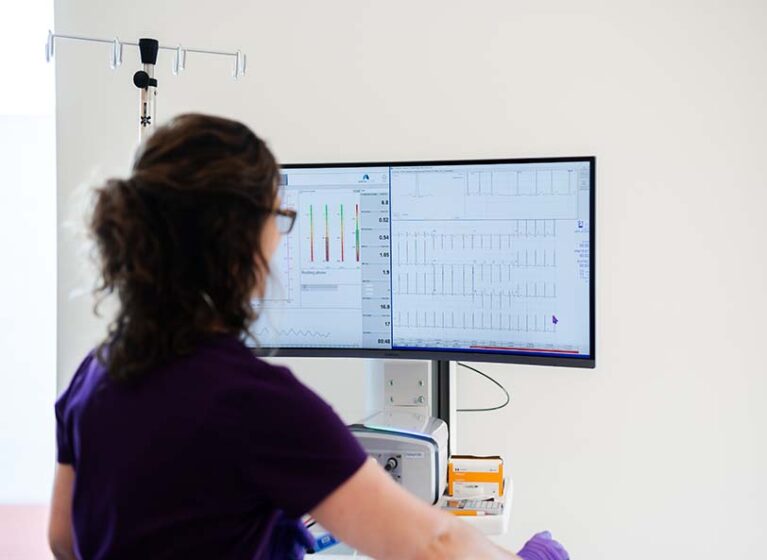
For most kids, the guidance on exercise is clear: Yes, please.
For developing children, physical activity can improve heart health and establish lifelong benefits. Participating in sports promotes:
- Improved mental health
- Fewer risky behaviors
- Higher academic achievement
- Better social skills and responsibility
- Enhanced concentration
Some studies link sports participation to a more positive attitude and better creativity. And the changes are more than skin deep. Athletics also improves:
- Bone strength
- Heart health
- Muscular fitness
But for kids with genetic conditions that affect their heart, traditional advice often leans towards activity restriction, depriving them of these benefits.
Thanks to advancements in pediatric sports cardiology and growing pediatric-specific heart data, there’s more room for discussion in these gray areas. Peter Dean, MD is a pediatric sports cardiologist at UVA Health Children’s and the medical director of the pediatric exercise stress laboratory.
In both a retrospective study and new research looking at the unique cardiology challenges of the pediatric athlete, it’s apparent that the decision to participate in sports, despite the presence of cardiac conditions, is a complex one and one where a shared decision-making model is especially useful.
Heritable Thoracic Aorta Disorders
Historically, Marfan syndrome, the most well-known heritable thoracic aorta disorder, wasn’t diagnosed until the late teen or early adult years. Sometimes, tragically, it wasn’t diagnosed until autopsy on a young adult whose aorta spontaneously dissected.
“But we’ve gotten better at diagnosis,” says Dean. “And we’ve gotten better at treatment.”
Quality of life is an important part of that treatment. Should a child diagnosed at 5 be preemptively disqualified from sports participation based on a genetic test that may never lead to symptoms? Dean thinks we should reconsider these blanket restrictions.
While exercise can’t prevent aortic dissection, it still offers many health benefits, including improving overall heart health. “Marfan syndrome also isn’t protective against other heart conditions,” Dean says. That means that inactivity carries risks as well.
In a retrospective study at UVA Health, patients with heritable thoracic disorders who participated in sports reported better quality of life without an increased surgical risk.
Pediatric-Specific Challenges to Sports Cardiology
Caring for pediatric patients requires specialized skills. Pediatricians must:
- Use plain language and relatable metaphors
- Work with short attention spans
- Recognize symptoms children may not realize are abnormal
- Collaborate with both the patient and the parents/guardians
A child born with a congenital heart defect doesn’t necessarily understand that what they’re experiencing is out of the ordinary. Whether it’s a heart that beats too quickly or feeling faint after working out, if it’s all they know, they’re unlikely to report it as a concerning symptom.
While an adult patient may come in complaining of a new pain in their chest, pediatric cardiologists often have to help patients find the words to describe their experience. Pediatricians also have more familiarity with problems that are more likely to occur in young people.
“In a pediatric patient, the list of probable causes is different,” Dean agrees.
Causes of heart disorders in school-age children include:
- Congenital heart disease
- Congenital coronary anomalies
- Genetic cardiomyopathies
- Wolff-Parkinson-White syndrome
- Long QT syndrome
- Catecholaminergic polymorphic ventricular tachycardia
- Hereditary thoracic aortic diseases
- Kawasaki disease
- Myocarditis
All of these issues aren’t as common in adult patients.
Heart Changes & Identifying Problems
For some kids, a large heart is a serious medical condition. For others, this anatomical change is an indicator of their athletic achievements. But how can we tell the difference? And what dynamic changes is the pediatric heart capable of when exposed to high-intensity exercise from a young age?
Dean’s recent review paper noted that while these changes in response to exercise are well chronicled for adults, they’re not well documented in pediatric patients. And some nuances in pediatric athletic test results would be deeply concerning in an adult patient.
Cardiac restructuring happens in both pediatric and adult patients, but in children the changes manifest differently. Left ventricular restructuring is particularly pronounced during puberty. Unfortunately, imaging guidelines for what is and isn’t normal aren’t available for pediatric athletes. For this reason, Dean encourages providers to really think about how they’ll include imaging in their assessment of a pediatric patient’s ability to safely participate in sports.
Large Team of Specialists
Dean is also emphatic that one of the things he feels fortunate about is the depth of the pediatric cardiology team available at UVA Health Children’s — from a comprehensive heart genetics program to heart specialists who can focus on areas like rhythm disorders or HCM.
“Knowing more about the specific genetic variant definitely helps to inform care as some genetic variants are higher risk than others,” Dean explains. “When I meet a patient, I can incorporate the information we know about the patient, the echocardiograms, the MRIs, and the genetic variant and come up with a shared decision with the patient and the family to make sure that we are optimizing quality of life and minimizing the risk.”
Shared Decision Making for Athletes with Cardiovascular Conditions
With pediatric heart patients, the entire family needs to come together for any decision being made and when sharing test results. It’s also much more usual for the actual patient to defer to their parents and want to involve them as more active decision-makers than an adult patient would. For pediatric patients, this is normal and often a healthy step in processing.
Through serial evaluations, this shared decision-making framework is revisited. These regular visits are crucial, since serious cardiovascular conditions can be missed on an initial visit. There’s no data helping teams decide how often follow-up is necessary, or what components should be present at each of these visits.
But talking through these details and finding the right recommendations for each situation can deliver solutions that are effective and deliver both high-quality health outcomes and a better quality of life.